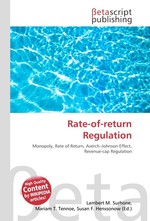

Ожидаемое поступление (если вы сделаете заказ прямо сейчас): 02.01.2026; планируемая отправка: 03.01.2026
Ожидаемое поступление (если вы сделаете заказ прямо сейчас): 07.01.2026; планируемая отправка: 08.01.2026
Технические характеристики
Please note that the content of this book primarily consists of articles available from Wikipedia or other free sources online. Rate-of-return regulation is a system for setting the prices charged by regulated monopolies. The central idea is that monopoly firms should be required to charge the price that would prevail in a competitive market, which is equal to efficient costs of production plus a market-determined rate of return on capital. Rate-of-return regulation has been criticized because it encourages cost-padding, and because, if the allowable rate is set too high, it encourages the adoption of an inefficiently high capital-labor ratio. This is called the Averch–Johnson effect. Rate-of-return regulation was dominant in the US for many years. However, as other countries have introduced monopoly regulation, often following the privatization of nationalized industries, they have mostly adopted other systems, such as price-cap regulation and revenue-cap regulation, which are seen as having better incentive properties. However, it has been argued that all systems of regulation converge to rate-of-return regulation in the long run.